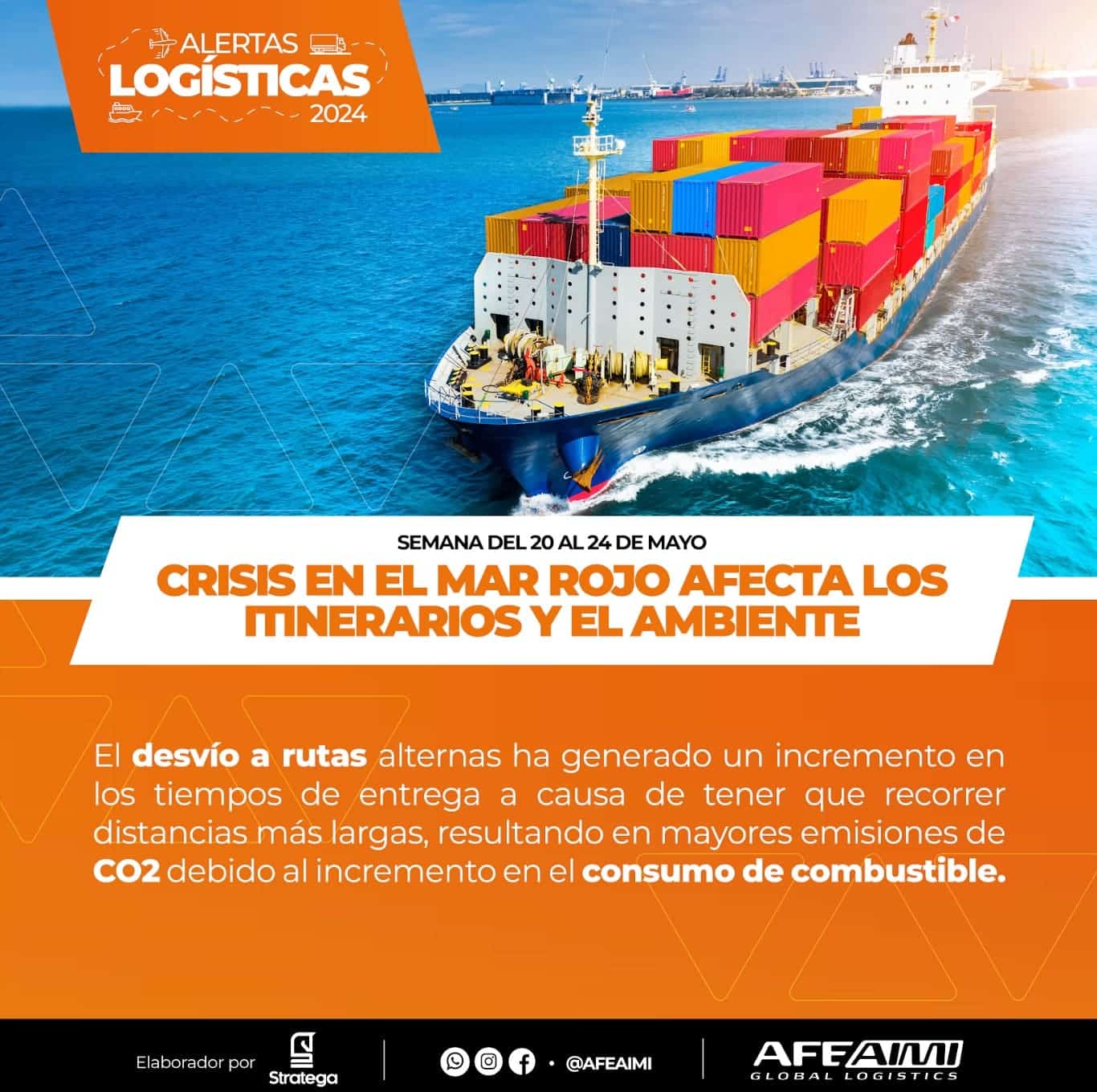Summary of the 2024 Logistics Update Webinar, where various topics were covered, including the impact of the pandemic, updates, and recent changes in Costa Rica’s customs sector.
The Influence of the Suez Canal on Latin America and Costa Rica: A Logistics Breakdown
Introduction:
In the context of the current crisis in the Suez Canal, it is crucial to understand how this event affects Latin America and, more specifically, Costa Rica. Although our economy may seem small compared to others, the repercussions of this geopolitical conflict can resonate in surprising ways.
Conexiones Geopolíticas:
Andrei Calderón, a geopolitics expert, provides essential context. In a hyper-connected world, logistics routes, while efficient, can become vulnerable due to unforeseen events. The Suez Canal, located in the Red Sea, is a strategic point through which approximately 30% of global maritime trade passes. Its temporary closure, resulting from geopolitical conflicts in the region, directly affects the flow of global commerce.
Critical Points:
Calderón highlights other key points, such as the Bab al-Mandeb Strait and the Panama Canal, which are also facing challenges. The conflict in the Middle East has triggered events that impact these routes, raising concerns about congestion and rising logistics costs.
Impact on Businesses and Logistics Costs:
International shipping companies such as MSC and Maersk have chosen to reroute away from the Suez Canal, taking longer paths around the Cape of Good Hope. This diversion of up to 5,000 additional kilometers results in higher logistics costs and extended transit times of two to three weeks.
Conclusion
The impact on companies, especially in Latin America, lies in the rising costs and delays in the delivery of goods. It is imperative to stay informed about these developments in order to adapt strategically to the changes in the global logistics landscape.
Although this scenario is geographically distant, it demonstrates how international events can have a significant impact even in faraway regions. We are all connected within this global network, and understanding these dynamics is essential for adaptation and informed decision-making in the business world.
Local Logistics Overview and Challenges in Caldera for 2024
Introduction:
In a global context of constant change, it is essential to take a close look at the state of local logistics and the challenges faced in Caldera, one of Costa Rica’s most important ports. In this analysis, we will explore the current problems in Caldera, the legislative changes affecting operations, and the outlook for the near future.
Challenges in Caldera and Future Perspectives:
Caldera, as a central point in our logistics infrastructure, faces a series of challenges that demand immediate solutions. Congestion, lack of investment in infrastructure, and legal obstacles are pressing issues that require attention. Furthermore, it is crucial to evaluate what the future holds and how we can prepare to address these challenges effectively.
Legislative Changes and Their Impact on Logistics:
Changes in customs and trade legislation are transforming the logistics landscape. It is essential to understand how these modifications will affect operations and what measures must be taken to adapt. The implementation of new regulations may pose operational and financial challenges, but also opportunities to improve efficiency and competitiveness.
National Logistics Infrastructure and Development:
At the national level, Costa Rica faces challenges in its logistics infrastructure that affect the country’s ability to compete in the global market. Investment in roads, ports, and transportation systems is crucial to improve connectivity and facilitate trade. These deficiencies must be addressed strategically and collaboratively to drive economic growth and sustainable development.
Future Perspectives and Actions:
For 2024, it is vital to adopt a proactive approach to overcome the challenges in Caldera and strengthen local logistics. This requires strategic planning, investment in infrastructure, and collaboration between the public and private sectors. By working together to implement innovative and sustainable solutions, we can build a more efficient and competitive logistics future for Costa Rica.
Conclusions:
The local logistics landscape presents significant challenges but also opportunities for growth and improvement. By addressing the issues in Caldera, adapting to legislative changes, and improving infrastructure, we can lay the foundation for a more promising and competitive logistics future in 2024 and beyond.
Lessons and Challenges in the Post-Pandemic Era Introduction:
Introduction:
The COVID-19 pandemic has shaken the foundations of the global supply chain, generating significant changes in the way companies operate and adapt. In this analysis, we will examine the lessons learned during the pandemic and the challenges faced in the post-pandemic era, focusing on business agility, risk management, technological innovation, and human capital development.
Business Agility and Adaptability:
A key lesson from the pandemic has been the importance of business agility and adaptability. Companies were forced to quickly adjust their strategies and operational processes to cope with sudden changes in demand, supply chain disruptions, and restrictions imposed by lockdowns. Those organizations that were able to adapt quickly to new market conditions managed to maintain their competitiveness and resilience.
Risk Management and Strategic Planning:
La pandemia también resaltó la necesidad de una sólida gestión de riesgos y una planificación estratégica efectiva. Las empresas tuvieron que identificar y mitigar los riesgos emergentes, desde interrupciones en la cadena de suministro hasta cambios en la demanda del consumidor. Aquellas que contaban con planes de contingencia bien desarrollados y una visión estratégica a largo plazo lograron minimizar el impacto de la pandemia en sus operaciones y mantener la continuidad del negocio.
Technological Innovation and Data Analysis:
The pandemic accelerated the adoption of digital technologies within the supply chain. From the use of cloud collaboration platforms to the implementation of real-time data analytics solutions, companies sought new ways to improve operational efficiency and supply chain visibility. Data analysis became an invaluable tool for predicting market trends, optimizing inventory management, and making evidence-based strategic decisions.
Human Capital Development and Organizational Resilience:
Por último, la pandemia destacó la importancia del desarrollo del capital humano y la resiliencia organizacional. Las empresas tuvieron que invertir en la formación y capacitación de su personal para adquirir nuevas habilidades y adaptarse a los cambios en el entorno laboral. Aquellas organizaciones que fomentaron una cultura de aprendizaje continuo y apoyaron el bienestar de sus empleados lograron mantener altos niveles de compromiso y rendimiento durante la crisis.
Conclusions:
As we move into the post-pandemic era, it is essential for companies to apply the lessons learned during the crisis and prepare to face emerging challenges with a comprehensive approach. This includes maintaining business agility, strengthening risk management, driving technological innovation, and developing human capital. Organizations that can adapt quickly to market changes and capitalize on emerging opportunities will be best positioned to thrive in the new business normal.
Impact of Nearshoring: Challenges and Strategies for Human Resource Development Introduction:
Introduction:
The phenomenon of nearshoring has redefined global business strategies, presenting both challenges and opportunities for host countries. In this analysis, we will examine in detail how to maximize the potential of nearshoring through human resource preparation, addressing challenges of adaptation, training, and infrastructure development.
Challenges of Rapid Adaptation and Investment Attraction:
Nearshoring has led to a rapid evolution in supply chains, requiring agile adaptation by host countries. The attraction of foreign investment depends largely on a country’s ability to adapt quickly to market demands, implement favorable policies, and create a stable and business-friendly environment.
Human Resource Training:
Training personnel is essential to fully capitalize on nearshoring opportunities. Specialized training programs, in collaboration with educational institutions and technical training centers, are crucial for developing the necessary skills within the local workforce. Furthermore, continuous training and professional development are key to keeping up with the industry’s changing demands.
Desafíos de Infraestructura y Planificación Estratégica:
La infraestructura adecuada es un requisito previo para el éxito del Nearshoring. La mejora de la infraestructura logística, incluyendo puertos, carreteras y sistemas de transporte, es esencial para garantizar una operación eficiente y rentable. Además, la planificación estratégica a largo plazo es fundamental para anticipar y abordar los desafíos futuros, asegurando la sostenibilidad y el crecimiento continuo del Nearshoring.
The Importance of Human Resources in Investment Decisions:
The availability of skilled labor is a determining factor in foreign investment decisions. Companies consider the quality and availability of human resources when assessing the feasibility of establishing operations in a host country. Therefore, investing in the development and training of human resources is crucial to attract and retain long-term investment, thereby driving economic growth and prosperity.
Conclusions:
Nearshoring offers significant opportunities for economic development and job creation in host countries, but its success depends largely on the preparation and development of local human resources. Governments and businesses must work together to implement effective training programs and policies, improve infrastructure, and promote a favorable business environment. Only through a combination of adaptability, investment in human resources, and strategic planning can we optimize the potential of nearshoring and generate sustainable, equitable growth in the region.



